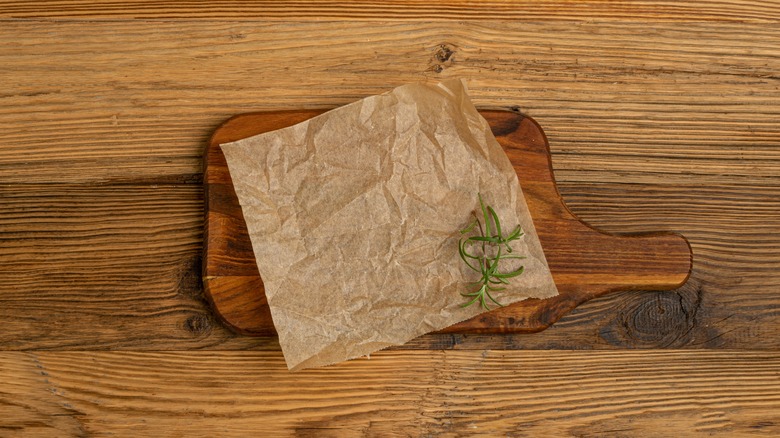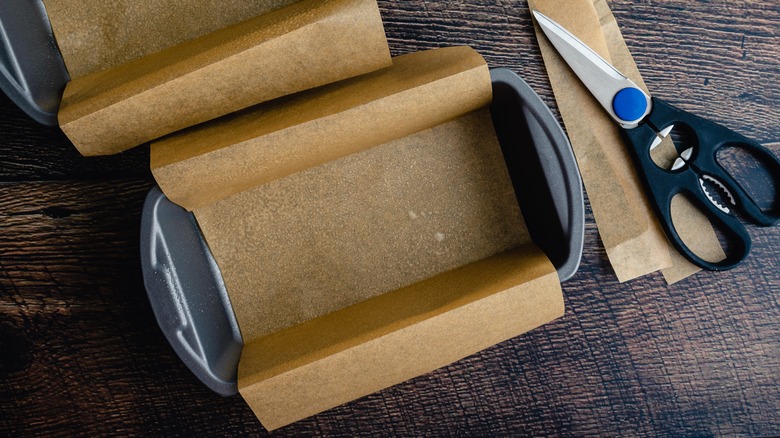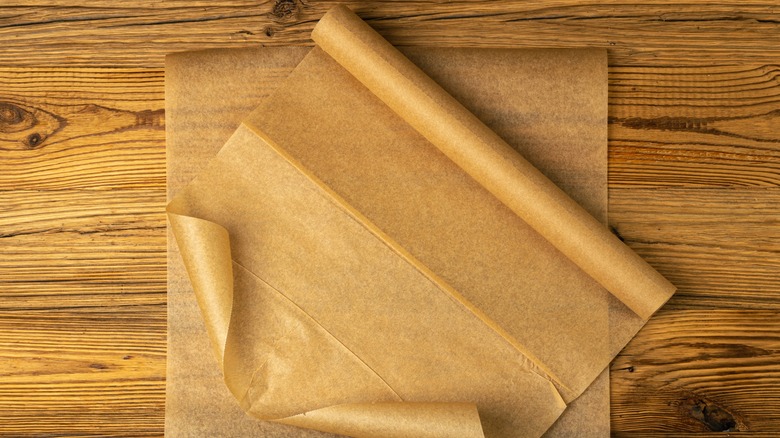Wait, Are You Supposed To Wet Parchment Paper?
If you're looking to save time on cleanup when cooking and baking, there's no simpler way to do so than to line your pans with parchment paper. It's super easy to do with flat pans that are similar in shape to the paper — just add a layer and you're done. But it becomes a little more challenging when lining a deeper baking dish, like the ones you might use for baking bread or cake, or making a casserole.
Because parchment paper tends to be somewhat stiff, it's more difficult to neatly fit it into the corners of these types of pans. But, there's one simple way to fix the situation — wet your parchment paper first.
All you need to do is scrunch up the paper and dampen it with water, then be sure to remove any excess moisture by squeezing it out. Once ready, simply press the paper into the bottom of the pan and up the sides. The moisture will make it more pliable and may even help it to more easily adhere to the inside surfaces of the pan so that the paper stays in place while you're pouring in the batter or other wet ingredients.
Why parchment paper is such a blessing for baking
Outside of the fact that parchment paper lining saves time by eliminating the need for heavy duty scrubbing after cooking and baking, it also makes it easier to remove food from the pan. The reason is because the paper — often made of wood pulp or cotton fiber — is typically coated on at least one side with silicone or Quilon, making it non-stick. The treatment also makes the paper resistant to heat so that it can be used in the oven for baking or roasting at high temperatures (up to 425 degrees Fahrenheit), though care should be taken to avoid allowing the paper to touch hot surfaces inside the oven.
In addition to acting as a non-stick surface that protects your pans, parchment paper has a number of other practical uses. You can put it on your cutting board to keep it clean when you're slicing and dicing. Or, spread it out on your counter when you're rolling dough. You can also extend the paper over the edges of your pan to create handles to help you lift your breads or brownies out after baking. Parchment paper is also perfect for storing bacon or wrapping up compound butter, and you can even roll it up to make a piping bag. For another convenient use unrelated to cooking, you can also use it to remove hard water stains.
More tips for working with parchment paper
While wetting your parchment paper is a great way to make it easier to work with, there are a few other things you can do to get the best results when working with this kitchen tool. First, be sure to always place the parchment paper in the pan with the shiny side up. This will help ensure that you're maximizing the paper's resistance to food sticking to it and it will eliminate any need for spray or oil.
One issue that you may run into with parchment paper is a tendency for the edges to curl inwards once it's cut from the roll. While that won't be an issue if you moisten it before laying in the pan, even if you choose not to wet the paper, there's still a solution that prevents parchment paper from curling. Simply ball up the sheet in your hand before spreading it and, voila!, it should lay perfectly in the pan.
Finally, if you're using the paper to keep your counters flour-free while rolling out dough, you may find that it's apt to slide around. To keep it in place, try spritzing the counter with water or cooking spray before laying the parchment paper down, or use a bit of the dough to adhere the corners of the paper to the counter.



